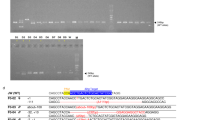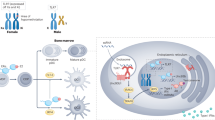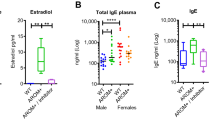Abstract
When hybrid mice are injected with spleen cells from one of the parent strains, they develop symptoms leading to death. Animals dying from this “homologous disease” frequently have enlarged adrenal glands. The possibility that this disease results from adrenal hyperactivity is explored by investigating two of its features—thymic involution and reactions of peripheral lymphoid tissue.
This is a preview of subscription content, access via your institution
Access options
Subscribe to this journal
Receive 51 print issues and online access
$199.00 per year
only $3.90 per issue
Buy this article
- Purchase on Springer Link
- Instant access to full article PDF
Prices may be subject to local taxes which are calculated during checkout
Similar content being viewed by others
References
Simonsen, M. T., Acta Path. Microbiol. Scand., 40, 480 (1957).
Billingham, R. E., and Brent, L., Transplantation Bull., 4, 67 (1957).
Martinez, C., Smith, J. M., and Good, R. A., Proc. Soc. Exp. Biol. and Med., 106, 572 (1961).
Trentin, J. J., Proc. Soc. Exp. Biol. and Med., 92, 688 (1956).
Trentin, J. J., Proc. Soc. Exp. Biol. and Med., 96, 139 (1957).
Trentin, J. J., Fed. Proc., 17, 461 (1958).
Kaplan, H. S., and Rosston, B. H., Transplant. Bull., 6, 107 (1959).
Santisteban, G. A., and Dougherty, T. F., Endocrinology, 54, 130 (1954).
Overman, J. R., and Hanan, R., Proc. Soc. Exp. Biol. and Med., 82, 427 (1953).
Hanan, R., and Overman, J. R., Proc. Soc. Exp. Biol. and Med., 84, 420 (1953).
Medawar, P. B., and Sparrow, E. M., J. Endocrinol., 14, 240 (1956).
Char, D. F. B., and Kelley, V. C., Proc. Soc. Exp. Biol. and Med., 109, 599 (1962).
Heim, L. R., Good, R. A., and Martinez, C., Proc. Soc. Exp. Biol. and Med., 122, 107 (1966).
Hildemann, W. H., Gallagher, B. A., and Walford, R. L., Amer. J. Path., 45, 481 (1964).
Gowans, J. L., and Knight, E. J., Proc. Roy. Soc., 159, 257 (1964).
Harris, J. E., and Ford, C. E., Nature, 201, 884 (1964).
Billingham, R. E., Defendi, V., Silvers, W. K., and Steinmuller, D., J. Nat. Cancer Inst., 28, 365 (1962).
Kaplan, H. S., and Rosston, B. H., Stanford Med. Bull., 17, 77 (1959).
Dougherty, T. F., and White, A., Amer. J. Anat., 77, 81 (1945).
Ringertz, N., Fagraeus, A., and Berglund, K., Acta Path. Microbiol. Scand., 93, 45 (1952).
Author information
Authors and Affiliations
Rights and permissions
About this article
Cite this article
HEIM, L., MARTINEZ, C. & GOOD, R. Cause of Homologous Disease. Nature 214, 26–29 (1967). https://doi.org/10.1038/214026a0
Issue Date:
DOI: https://doi.org/10.1038/214026a0
Comments
By submitting a comment you agree to abide by our Terms and Community Guidelines. If you find something abusive or that does not comply with our terms or guidelines please flag it as inappropriate.



